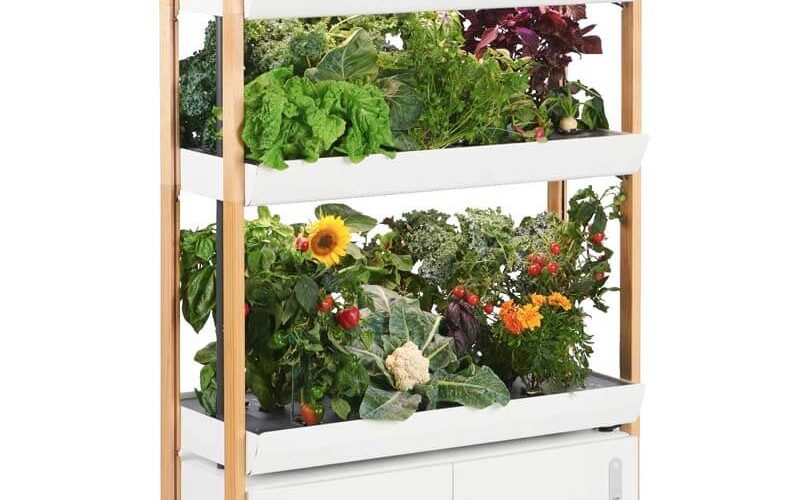Hydroponics is a method of growing plants without soil, using nutrient-rich water instead. This approach can be a great way to grow fresh produce in your own home. If you’re interested in building your own home hydroponics system, then you’re in luck! In this article, we’ll walk you through everything you need to know to get started.
Benefits of a Home Hydroponics System
There are many reasons why you might want to build a home hydroponics system. Here are just a few of the benefits:
Saves space: Hydroponic systems can be much more space-efficient than traditional gardening methods. You can grow more plants in a smaller area.
Saves water: Hydroponics systems use much less water than traditional gardening methods.
Saves time: Because hydroponics systems are self-contained, they require less maintenance than traditional gardening methods.
Higher yields: Hydroponics systems can produce much higher yields than traditional gardening methods.
Types of Hydroponics Systems
There are several different types of hydroponics systems, each with its own pros and cons. Here are a few of the most common types:
Deep Water Culture: This type of system uses a floating platform to support the plants, which are suspended in nutrient-rich water.
Nutrient Film Technique: This type of system uses a sloping channel to support the plants, with a thin film of nutrient-rich water flowing over the roots.
Drip System: This type of system uses a pump to drip nutrient-rich water onto the plants.
Aeroponics: This type of system suspends the plants in a mist of nutrient-rich water.
What You’ll Need
Before you start building your hydroponics system, you’ll need to gather a few supplies:
Container: This will be the main body of your hydroponics system. You can use any watertight container, such as a plastic tote or a large aquarium.
Water Reservoir: This is where your nutrient solution will be stored. You’ll need a separate container for this.
Nutrient Solution: This is the mixture of water and nutrients that will feed your plants.
Pump: This will circulate the nutrient solution through your hydroponics system.
Lighting System: Your plants will need light to grow. You can use LED grow lights or fluorescent lights.
Growing Medium: This is what will support your plants. You can use materials like perlite, vermiculite, or coconut coir.
Building Your Hydroponics System
Now that you have all your supplies, it’s time to start building your hydroponics system!
Choosing Your Container
The first thing you’ll need to do is choose a container for your hydroponics system. You can use any watertight container, such as a plastic tote or a large aquarium. Just make sure it’s big enough to hold your plants and your water reservoir.
You’ll want to choose a separate container for your water reservoir. This container should be slightly larger than your pump, to ensure that your pump is fully submerged in the nutrient solution.
Adding Your Nutrient Solution
Once you’ve set up your water reservoir, you can add your nutrient solution. The exact mixture will depend on the plants you’re growing, but a general rule of thumb is to use 1-2 tablespoons of nutrient solution per gallon of water.
Installing Your Pump
Your pump is what will circulate the nutrient solution through your hydroponics system. You’ll want to install your pump in your water reservoir, making sure it’s fully submerged.
Installing Your Lighting System
Your plants will need light to grow, so you’ll need to install a lighting system. You can use LED grow lights or fluorescent lights, depending on your budget and the types of plants you’re growing. Be sure to position your lights so that they’re evenly spaced and provide sufficient coverage for all of your plants.
Planting Your Hydroponics System
Now that you’ve built your hydroponics system, it’s time to plant it! You’ll want to choose plants that are well-suited to hydroponics, such as lettuce, spinach, and herbs. You can start your plants from seed or purchase seedlings from a nursery.
When planting your hydroponics system, you’ll want to make sure that your plants are properly supported by your growing medium. You can use materials like perlite, vermiculite, or coconut coir to support your plants.
Maintaining Your Hydroponics System
Maintaining your hydroponics system is relatively easy, but it’s important to stay on top of it to ensure that your plants stay healthy. Here are a few maintenance tips:
- Check your nutrient solution levels regularly, and top them up as needed.
- Monitor your pH levels, and adjust them as needed.
- Check your pump and lighting system regularly to ensure they’re working properly.
- Keep an eye out for pests and disease, and address them promptly if they appear.
Troubleshooting Your Hydroponics System
If you run into any issues with your hydroponics system, don’t worry! Here are a few common problems and their solutions:
Algae growth: If you notice algae growing in your hydroponics system, reduce the amount of light your plants are receiving, and make sure your water reservoir is covered to prevent light from getting in.
pH imbalance: If your pH levels are too high or too low, adjust your nutrient solution accordingly. You can use pH testing strips to monitor your levels.
Pump failure: If your pump stops working, check to make sure it’s fully submerged, and that the power cord is securely plugged in.
Root rot: If you notice the roots of your plants turning brown or mushy, this could be a sign of root rot. To address this, reduce the amount of water your plants are receiving, and make sure your growing medium is well-aerated.
Conclusion
Building a home hydroponics system is a fun and rewarding project that can help you grow fresh produce right in your own home. By following the steps outlined in this article, you’ll be well on your way to creating a thriving hydroponics system that really works!




